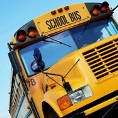
Alabama Begins Pilot School Bus Seat Belt Study
The University Transportation Center for Alabama, headquartered at The University of Alabama, is conducting a pilot study to assess the impact of installation of lap/shoulder seat belts on a limited number of Alabama school buses.
From effects on student behavior, to monitoring the extra time devoted to buckling up at each stop, the study will provide information about school buses with seat belts for possible adoption throughout the state. The project involves four areas for research, including review of national practices and what other states have found, alterations needed in the Alabama bus fleet, analysis of Alabama school bus crash data, and a cost-benefit analysis.
Each of the 12 new buses has been equipped with various types of three-point seat belts. Four ceiling-mounted video cameras are installed on each bus to gather data on the level of restraint use, to review the percentage of students using the belts and the percentage of students using the belts properly, to investigate if using the belts keeps students from moving into the aisle and out of the protective compartment provided by the seats, and to monitor time devoted to buckling at each stop.
"This is a ground-breaking research project in safety for the state of Alabama," explained Dr. Dan Turner, professor of civil engineering and the principle investigator of the research team. "Five states throughout the country now have laws that require some form of seat belts in school buses. The University of Alabama team is reviewing the effectiveness of different types and uses of seat belts in these states, and UA is using technology to gather information about school bus seat belt use and safety in Alabama. Our state is concerned about the safety of our kids, and we're leading the nation by proactively reviewing safe transportation methods."
Since the new school buses were delivered late in the academic year, the research team has not yet received enough information to start analyzing results. In addition to the cameras on the buses, parents and school administrators have received questionnaire surveys about the buses with seat belts.
The study comes after a tragic school bus accident in Huntsville, in which Gov. Bob Riley appointed a group to review laws in other states and interview seat-belt experts. The group recommended that Alabama test buses with seat belts. Alabama lawmakers then allocated more than $300,000 for a three-year pilot program in 10 school districts. The state purchased 12 new school buses with seat belts. The research grant was awarded to the University Transportation Center for Alabama.